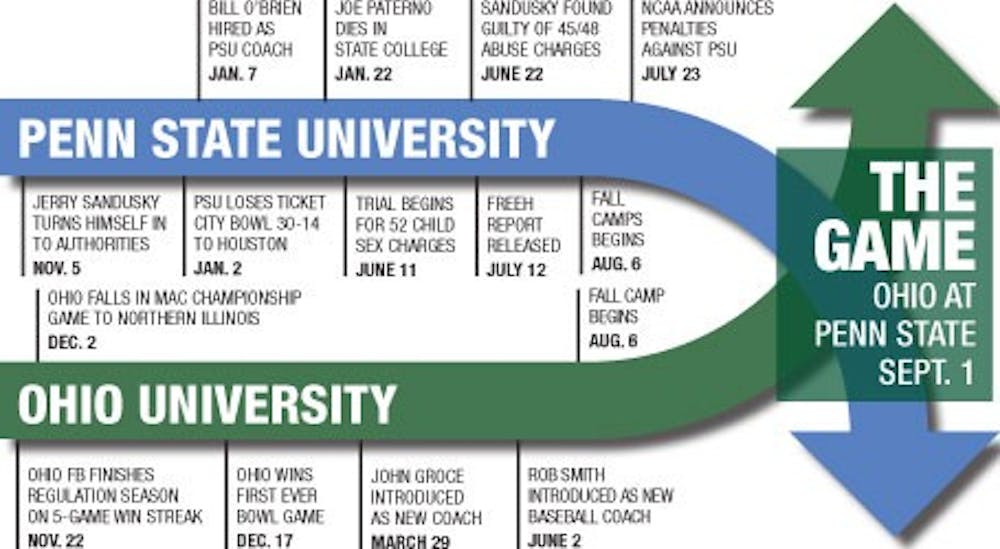When Ohio bursts onto the field at Beaver Stadium Saturday, it will be met by Penn State, which will have emerged only moments earlier from a locker room decorated with the same colors forever engrained in the memory of abused children and their families.
The verdict captured the nation’s attention: Former Penn State assistant coach Jerry Sandusky has been found guilty on 45 of 48 counts of sexual abuse.
When the Nittany Lions make their way onto the field and look up at the sea of trademark Penn State white, it might be the first step toward washing away the pain that has plagued the program during the past 10 months.
Eight months before a grand jury indicted Sandusky on 40 counts of sex crimes against young boys, the U.S. Department of Education’s Office for Civil Rights released the Dear Colleague Letter, which explicitly laid out schools’ obligations in dealing with sexual assault.
Although the former resulted in more headlines, it was the latter that captured OU officials’ attention.
As a result, OU is in the process of rolling out a new sexual misconduct policy, replacing one that has been updated only three times in the past 25 years, most recently in 2006.
Ohio officials were quick to say the new policy, which was approved Aug. 3 and will go into effect at the beginning of the week, is not a reflection whatsoever of the Penn State scandal but is a reaction to the letter and its expectations.
“It was kind of the letter nationwide that said, ‘You’re on notice. These aren’t Title IX changes, but this is how it’s supposed to be enforced in a university setting and what we expect you to do,’ ” said Ardy Gonyer, assistant director for the Office of Community Standards and Student Responsibility.
The day-to-day face of the university’s sexual misconduct policy will not drastically change. All the usual avenues for reporting violations and policies for processing perpetrators remain largely constant, with policy definitions, rights and responsibilities expanded in more detail.
The policy specifically states that faculty, administrators, coaches, staff, graduate assistants and student employees have a “duty to report” any violations to the Office for Institutional Equity.
Previously, the policy was more vague, requiring “any member of the university community who receives a complaint of sexual harassment” to report it to the Office for Institutional Equity.
Fundamentally, the way sexual misconduct is dealt with on campus will be no different than before the policy was put in place. Laura Myers, executive director of the Office for Institutional Equity, said the policy puts in ink processes that were already common on the university level.
“It was time to refresh the policy and make sure that the rules of conduct accurately describe the process of handling issues when they come up,” Myers said, noting her department and others on campus have historically been proactive in dealing with sexual misconduct.
The most significant alterations come on the administrative end of the new policy. Previously operating as two sometimes-interacting campus units, the Office of Community Standards and Student Responsibility and the Office for Institutional Equity will work together more consistently, with the latter serving as a security blanket of sorts, making sure cases don’t slip through the cracks.
“We have always had a relationship with (the Office for Institutional Equity) and would always work together on civil rights issues, but now it’s changing to more them always being in the loop on sexual misconduct issues,” Gonyer said. “They’re sharing information with us too. It’s more collegial.”
The Division of Student Affairs’ sexual assault sanctioning guidelines are grouped into three distinctions, the most severe of which — an assault involving penetration — likely leads to expulsion. A one-year suspension looms for students who have physical contact with their victims and any other violations result in at least a semester-long suspension.
Other university factions operate in accordance to their own policies, in addition to the university’s.
Myers said Residential Housing takes an exceptionally proactive stance on sexual misconduct, assuring resident assistants are equipped to appropriately deal with any situations thrown their way. Campus Involvement also has an internal policy, she said.
Ohio Athletics operates entirely under university rules and sanctions, said Tom Symonds, Ohio assistant Athletics director for media relations.
It does not set additional guidelines for its student-athletes and other personnel but expects them to fall in line with the university policy.
Director of Athletics Jim Schaus said a significant portion of the department’s chain of command is established using “common sense.” Any situation in question of university policy is not handled internally and is appropriated to other university officials.
“When in doubt, nobody likes to be surprised,” he said. “So I think we try, whether it’s a coach to an athlete or a coach to athletic director — any organization, not only Athletics, wants to freely share. That’s something we really emphasize.”
Of course, no policy can ever keep ahead of the game when it comes to sexual misconduct. No matter the lengths the university establishes, the system will never keep problems from occurring.
“(The policy) is part what we’re doing and part aspirational,” Myers said. “We can’t always predict and can’t always prevent conduct, but how we respond is a measure of how safe we are as an institution.”
jr992810@ohiou.edu






